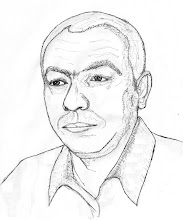David LaChapelle
Auguries of Innocence
Tony Shafrazi Gallery
544 West 26th Street
New York, NY 10001
212 274 9300
http://www.tonyshafrazigallery.com
With its over the top, kitsch notions of Holy War it is
difficult to get a handle on the recent exhibition "Auguries of
Innocence" by David LaChapelle (born March 11, 1963) at the Tony
Shafrazi Gallery in Chelsea. First you have to catch your breath after
the steep second floor walk up. Then get oriented to several spacious
galleries shock a block with enormous, cut out color photographs
creating a tableau of narrative images.
The first impression is that the life sized panoramas
resemble the lobby advertisements of a movie palace. The work seems to
be promoting some kind of spectacle or event. The flat, free standing
elements create a theatrical space. They could serve as the diagram for a
stage or movie set.
The aggressive stance of the exhibition, and its media
saturated delivery, makes one wonder why we are encountering this in an
art gallery? In that context just what is the intended audience and in
what sense is this art? Is the product on view destined for the homes of
collectors and eventually the galleries of museums?
Of course, these are not unique issues or conundrums.
There are ready paradigms for this approach. There is the absurdist,
sexually charged, proto pop of Jeff Koons or Matthew Barney. Those
comparisons deflate the sense of originality or outrageousness of the
LaChapelle project. In the familiar dialogue of the Shock of the New
each new generation, or individual artist, building on and extending
what came previously is mandated to up the voltage. It takes every
greater increments of energy to evoke the same results.
A consideration of this work reveals that formidable
resources went into its production. It evokes the notion that the artist
has reached a level of success to be able to create expensive work
with high production values. It would take a large cast of models,
costumes, set designers, gaffers, lighting crews, and grips to set up
the shoot. To say nothing of all the post production editing, printing
and construction.
Of course, for the movie industry, such a project is
small beer; but over the top for the art world. At least for artists who
have not reached the highest levels of the field where a new body of
work entails millions of dollars in fabrication, staff, and front money.
This is the norm for artists like Koons and Barney or Damien Hirst.
David LaCapelle aspires to swim in the same tank with the other sharks
of the art world..
Prior to the exhibition I had never heard of this
artist. Indeed, do I really want to know? While spectacular and wiggy on
first exposure, or at least engaging and amusing in its degeneracy, is
there a really compelling reason to discuss this work? Well, not really.
LaChapelle is hardly a topic for a future dinner party. It would take
too much time and energy to bring my friends up to speed with the basics
of the dialogue. Or even make a case for why it is interesting or
worthy of conversation. This is work that is site specific to high
rolling circles in New York, Vegas, Miami, or LA but makes little or no
sense in the heartland.
Like a lot of new and outrageous work it is destined
for the dust bin of memory. The half life of the shock of the new grows
ever shorter. LaChapelle is hardly original or even insightful in
recycling the familiar signifiers from blood smeared combatants in Holy
War to a central casting Jesus tending to all too real sheep. If you
look carefully you will find the gold painted pigs fornicating; a pig in
a poke. Or the usual nubile, nude babes and guys with remarkable
johnsons. Ho hum.
It appears that the artist got his big break at
Studio 54 where Andy Warhol invited the scantily clad busboy to shoot
for Interview. This led to gigs for Rolling Stone, Vanity Fair, GQ, and
Vogue. He went on to direct Elton John's show The Red Piano in Vegas at
Caesar's Palace. He has done music videos with Madonna and other tops of
the pops artists. He has published four books "LaChapelle Land" (1996)
"Hotel LaChapelle" (1999) "Artists and Prostitutes" (2006) and "Heaven
to Hell" (2006). He has won numerous awards at the Telluride, Sundance,
and Aspen Film Festivals.
Walking around Chelsea we encountered billboards
advertising the exhibition. This is unusual, but not unprecedented, in
the art world. It underscored the level of hype for the artist and his
work. It served as a kind of bench mark for the absurdity of excess that
indicates an art world driven by glamour and greed. LaChapelle is a Neo
Babylonian and academician of the crass. The real notion here is why
bother. As we slip into a state of social and economic oblivion will
this work take on the aura of a Biblical epic? Do these works represent
the handwriting on the wall? Do they illustrate everything that is wrong
about our decadent conumer culture? Is it all just a big joke and do we
laugh with or at Mr. LaChapelle? Or, have we missed the point, again?
Abonați-vă la:
Postare comentarii (Atom)




Niciun comentariu:
Trimiteți un comentariu